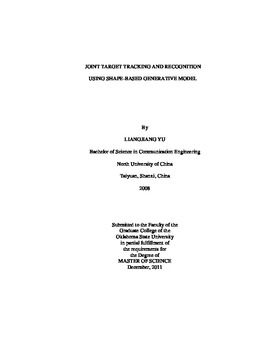| dc.contributor.author | Yu, Liangjiang | |
| dc.date.accessioned | 2014-04-17T20:09:30Z | |
| dc.date.available | 2014-04-17T20:09:30Z | |
| dc.date.issued | 2011-12-01 | |
| dc.identifier.uri | https://hdl.handle.net/11244/10301 | |
| dc.description.abstract | Recently a generative model that combines both of identity and view manifolds was proposed for multi-view shape modeling that was originally used for pose estimation and recognition of civilian vehicles from image sequences. In this thesis, we extend this model to both civilian and military vehicles, and examine its effectiveness for real-world automated target tracking and recognition (ATR) applications in both infrared and visible image sequences. A particle filter-based ATR algorithm is introduced where the generative model is used for shape interpolation along both the view and identity manifolds. The ATR algorithm is tested on the newly released SENSIAC (Military Sensing Information Analysis Center) infrared database along with some visible-band image sequences. Overall tracking and recognition performance is evaluated in terms of the accuracy of 3D position/pose estimation and target classification.</ | |
| dc.format | application/pdf | |
| dc.language | en_US | |
| dc.publisher | Oklahoma State University | |
| dc.rights | Copyright is held by the author who has granted the Oklahoma State University Library the non-exclusive right to share this material in its institutional repository. Contact Digital Library Services at lib-dls@okstate.edu or 405-744-9161 for the permission policy on the use, reproduction or distribution of this material. | |
| dc.title | Joint Target Tracking and Recognition Using Shape-based Generative Model | |
| dc.type | text | |
| osu.filename | Yu_okstate_0664M_11659.pdf | |
| osu.college | Engineering, Architecture, and Technology | |
| osu.accesstype | Open Access | |
| dc.description.department | School of Electrical & Computer Engineering | |
| dc.type.genre | Thesis | |
| dc.subject.keywords | electrical engineering | |
